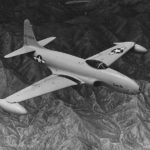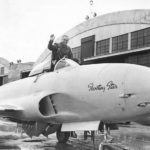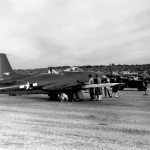P-80A 44-85004 in flight
P-80A 44-8499? Mitchel Field 1945
XP-80A 44-83021
Test Pilot Col. William Councill in P-80A-1 44-84999 1945
P-80 Shooting Star at Wright Field 1945
Lockheed XP-80A #01 44-83021 in flight
Lockheed YP 80A nose view
Jet fighter Lockheed P-80 Shooting Star left side
Jet fighters YP-80 44-83028 44-83029 Italy 1945. Vesuvio in background
Jet fighter P-80 Italy 1945
Jet fighter XP-80A “01” 44-83021 “Gray Ghost”
Prototype XP-80 Shooting Star 44-83020 1944
Lockheed P-80 Shooting Star – first jet fighter used operationally by the USAAF. The XP-80 was designed round a British de Havilland Goblin jet-unit which was supplied to the American authorities in July 1943, and turned over by Wright Field to the Lockheed company to power the prototype. In 143 days Lockheed had designed, built and flown prototype. Later, a General Electric power-unit was adopted for the YP-80 and the production P-80A.
Technical description
Low-wing cantilever monoplane. Laminar flow wing section with knife-sharp leading-edge. Centre-line el wing 50 mm behind the midpoint of the fuselage. Wings of equal taper and no dihedral. One-piece wing of aluminium-alloy construction. Normal ailerons with hydraulic boost control. Electrically-operated split flaps inboard of ailerons with separate fuselage flap interconnecting the wing flaps. Fuselage flap may be operated with or independent of the wing flaps. All-metal fuselage with semi-monocoque structure in three sections: nose, centre and aft. Nose section contains either armament or photographic equipment, and oxygen, radio equipment and adjustable landing light Centre section houses cockpit, fuel tanks and power-plant, with space below cockpit for hydraulic, fuel and radio equipment. Aft section incorporates the jet tail pipe and tail unit. Cantilever monoplane tail. All-metal construction with balanced control surfaces. Retractable tricycle landing gear. Main wheels raised inwardly into underside of wings. Nose wheel raised into fuselage Hydraulic retraction. Powered by General Electric I-40/Allison J33 centrifugal-flow jet unit in centre-section of fuselage with air intakes on either side of the fuselage forward of tho wing leading-edges. Aft section of fuselage, including the jet nozzle, removed by detaching 3 fittings mid tail pipe clamp for servicing and maintenance of jet unit. Complete engine may be changed in 20 minutes. Self-sealing fuel tanks in fuselage and wings . Streamline drop tanks may be carried at the wing tips (623 litres). Pressurised cockpit with Pilot’s ejection seat over leading-edge of wings. Sliding moulded cockpit canopy. Armoured windscreen. Steel armour plate on upper forward side of front bulkhead and behind pilot’s seat and head, with duralumin armour plate aft of front bulkhead. Cockpit pressure is automatically reduced when the combat gun switch is turned to prevent physical injury to pilot from explosive decompression should the canopy be pierced. Provision for use of G-suit. Armed with 6 x 12.7 mm machine-guns (300 rounds per gun) in lower portion of nose. Electric gyro-lead computing gun sight with reflex optical system. Guns and magazines may be removed and replaced in 15 minutes, without use of platforms or ladders. Complete gun nose can be replaced by nose containing camera equipment for photographic-reconnaissance duties. Gun camera in slight bulge in starboard air-intake duct. Bombs may be carried on wing-tip shackles in place of long-range tanks. Glass-smooth external finish. To attain this surface, rivets are cut and surface-ground. A zinc-chromato primer is applied, all butt-joints are cement-filled and flexible joints covered with organdy mesh tape. An undercoat is then upplied and final paint coat is baked on in special ovens big enough to hold entire aircraft. Light sanding and buffing follow. Finally, a specially-developed wax is sprayed on and polished.
Specifications
variant | P-80A |
crew | 1 |
wingspan (m) | 11,83 |
lenght (m) | 10,51 |
height (m) | 3,45 |
wing area (m2) | 22,07 |
empty weight (kg) | 3593 |
take-off weight (kg) | 5307 |
max take-off weight (kg) | 6305 |
engines | General Electric J33-GE-11 turbojets, 16,94 kN each or Allison J33-A-9 16,94 kN each |
fuel (l) | 1609 + 1250 |
speed (km/h) | 898 km/h at 0 m; 792 km/h at 12 192 m |
ceiling (m) | 13715 |
range (km) | 1255-2025 |
climb to | 6096 m – 5’30” |
bombs (kg) | 2 x 454 kg or 10 x 127 mm rockets |
armament | 6 x M2 12,7 mm |
Bibliography:
- Larry Davis: P-80/T-33/F-94 Shooting Star in Action, Squadron/Signal Publications; Aircraft No. 40
- David R. McLaren: Lockheed P-80/F-80 Shooting Star: A Photo Chronicle; Schiffer Military History Book
- Don Berliner: World War Two Jet Fighters: Scale Reference Data
- Rene J. Francillon: Lockheed Aircraft since 1913
- Various Authors: United States Army and Air Force Fighters 1916-1961, Harleyford Publications 1961
- Encyclopedia of US Air Force Aircraft and Missile Systems Vol. 1: Post WWII Fighters
- Bill Gunston: Jane’s Fighting Aircraft of World War II











